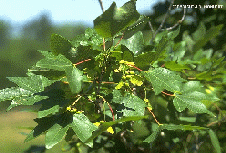

Big Toothed Maple
Acer grandidentatum Nutt.
Bigtooth maple is a deciduous shrub or small tree of variable
size. On dry sites it is often a shrub, with numerous stems reaching 20 feet in
height. On moist locations it often occurs as a single- or multiple-trunked tree
growing to 40 or 50 feet tall. Tree-sized Bigtooth Maple may attain diameters
of 12 inches. .Leaves are: opposite,
simple deciduous, less than 12.7 cm long and broad, orbicular, deeply lobed,
lobes blunt apex and teeth dark green above, pubescent below, turning red or
yellow. Has clustered flowers which bloom in April. The bark is smooth, thin,
and gray. Found in the Rocky Mountain area primarily
in moist sites such as wet canyons, valleys and the banks of mountain streams at
elevations of 1200 - 2100 feet mostly in canyons. Bigtooth
maple has a spotty distribution, occurring in mountainous areas from
southeastern Idaho and western Wyoming south to Arizona, New Mexico, western
Texas, and northern Mexico. It is most common along a north-south axis from
southeastern Idaho to central Utah, where it may form nearly solid stands. Grows
well in heavy clay soils. Trees need full light and a lot of space if they are
to grow well[98]. Plants are hardy to about -45°c when fully dormant.
Food Use: The sap is relatively rich in sugar and can be made into
a drink or concentrated into a syrup by boiling off the water. The syrup is used
as a sweetener on many foods. It can be harvested in late winter or early
spring, the flow is best on a warm sunny day after a frost. Trees on southern
slopes in sandy soils give the best yields. It is best to make a hole about 2
1/2 inches deep and about 4 feet above the ground.. Yields of 40 - 100 liters per tree can be obtained[. The best sap production comes from cold-winter areas
with continental climates. The inner bark is cooked, then dried, ground into a powder and then used as a
thickening in soups etc or mixed with cereals when making bread.
Animal Feed:
Big tooth maple provides browse for big game and livestock species but is
normally only consumed in small or moderate amounts. It is browsed heavily by
game and livestock. Big tooth maple is an important food source for moose in
southeastern Idaho and considered a key browse species. The seeds, buds, and
flowers of maples (Acer spp.) provide food for numerous species of birds and
small mammals. Squirrels and chipmunks eat the seeds, frequently storing them in
caches after removing the hull and wing.
